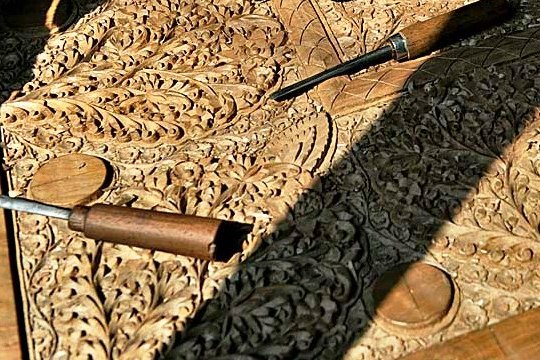
Kashmir is one of the few places in the world and the only place in India where walnut grows. Walnut grows here at an altitude of 5500-7500 feet above sea-level. Aliya Bashir reports.
The walnut tree which grows in Kashmir is made up of soft wood and takes carving very well. Its colour, grains and inherent lustre make it suitable for carving.
Carving is an art, and Kashmiri craftsmen are expert wood carvers. Craftsmen carve out exquisite and attractive designs on the various furniture and ornamental items. Kashmiri wood carving is known worldwide for its intricate and elaborate designs. Carved walnut wood-work is among the most important crafts of Kashmir.
Sultan Zain-ul-Abidin (1423-1474) popularly known as Budshah, gave a fillip to wood carving by inviting craftsmen from Samarkand. The designs are mostly the representation of fruits, flowers, leaves and twigs.
Chinar leaf impression is the most widely used wood carving design, from ancient times to date, in Kashmir. The valley’s walnut is recognizable for the colour and tone of walnut wood and the intricate motifs and styles.
Kashmir is also well known for the relief work on ‘Khatam-band’ ceilings, which in itself is a fine art .The art is displayed from thin panels of pine wood, and cut into geometrical designs. This craft finds expression in the various shrines, government buildings and homes of the very rich.
The cost of the woodcarving is dictated by its artistry and abundance. Wood carving is done on a variety of utility and decorative items made of walnut, ranging from small items like bowls, trays, cigarette boxes, wall plaques and table lamps to screens, bedsteads, beds and furniture.
For furniture, the price is dictated by the thickness of wood used. Most of the carved products bear motifs of rose, lotus, iris, bunches of grapes, pears and Chinar leaves.
Walnut wood from the root is almost black, and the grain here is much more pronounced than the wood of the trunk, which is lighter in colour.
The branches have the lightest colour, almost blonde, and have no noticeable grain. The intrinsic worth of the wood from each part of the tree differs with wood from the root being the most expensive.
The craft presents visually interesting effects even with plain polished surfaces. Nowadays plain surfaces and small carvings are preferred on trays, tables, bowls and other items.
“Woodcarving is our heritage as this art is continuing here from generations,” says Abdul Rehman, a wood carving cast artisan in Rajouri Kadal in the old city.
He says that the popular motifs of the carvings require a high level of expertise, patience and fortitude.
The Kashmir walnut woodcarving is usually practiced in the five main styles- Open or Lattice Work ( Jallidahr, Shabokdhar), Deep Carving (Vaboraveth), Semi Carving or Engraved Carving (Padri), Undercut (Khokerdar) and Shallow or Plain Carving (Sadikaam). The carving of furniture and smaller items is an elaborate process and involves high degree of skill and craftsmanship.













